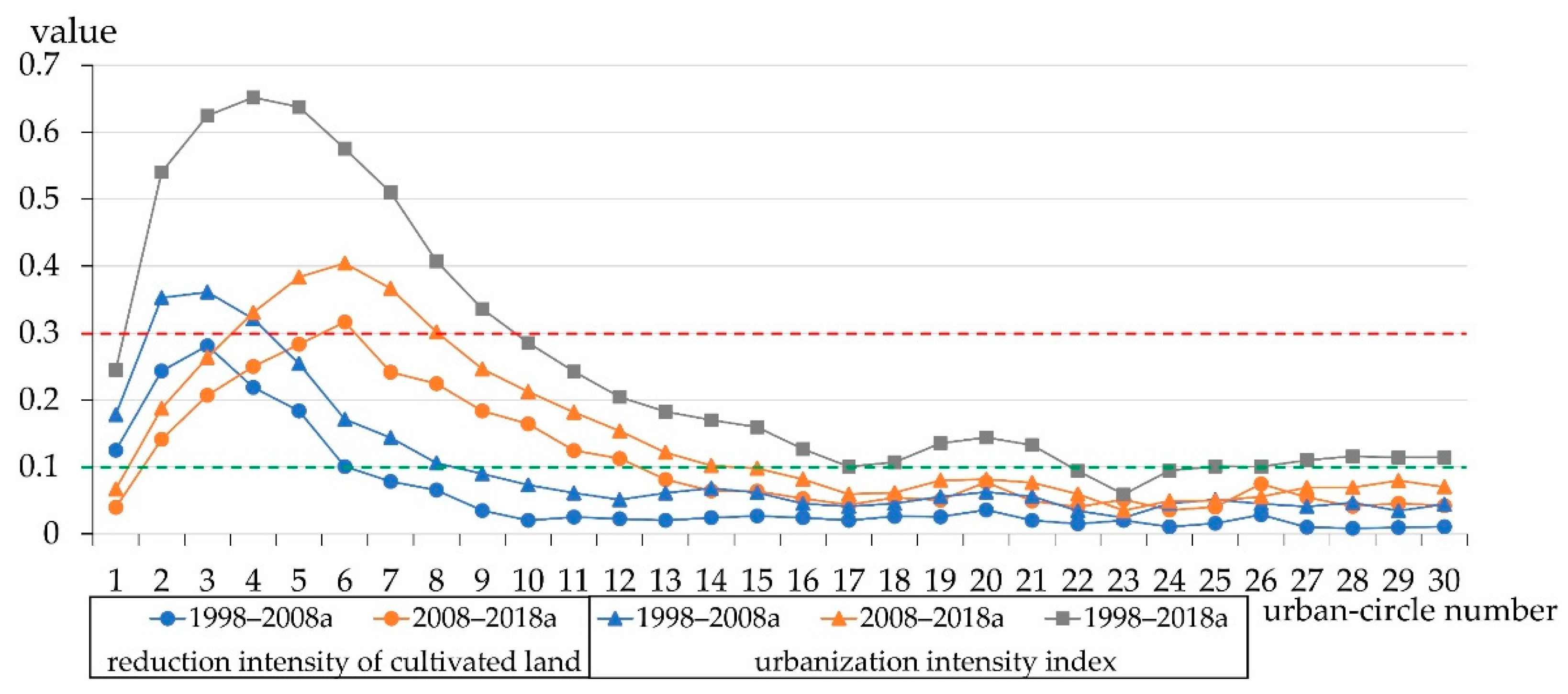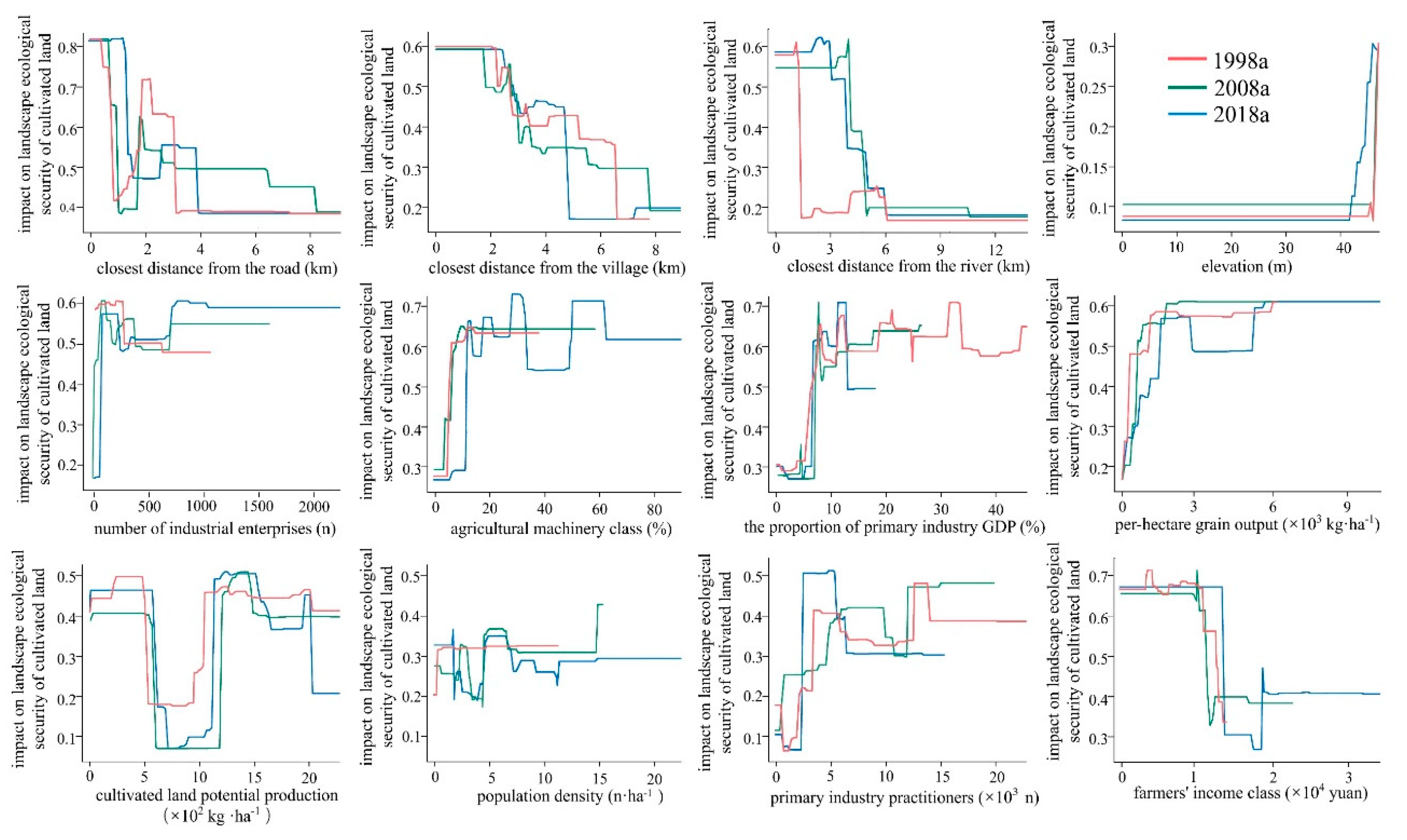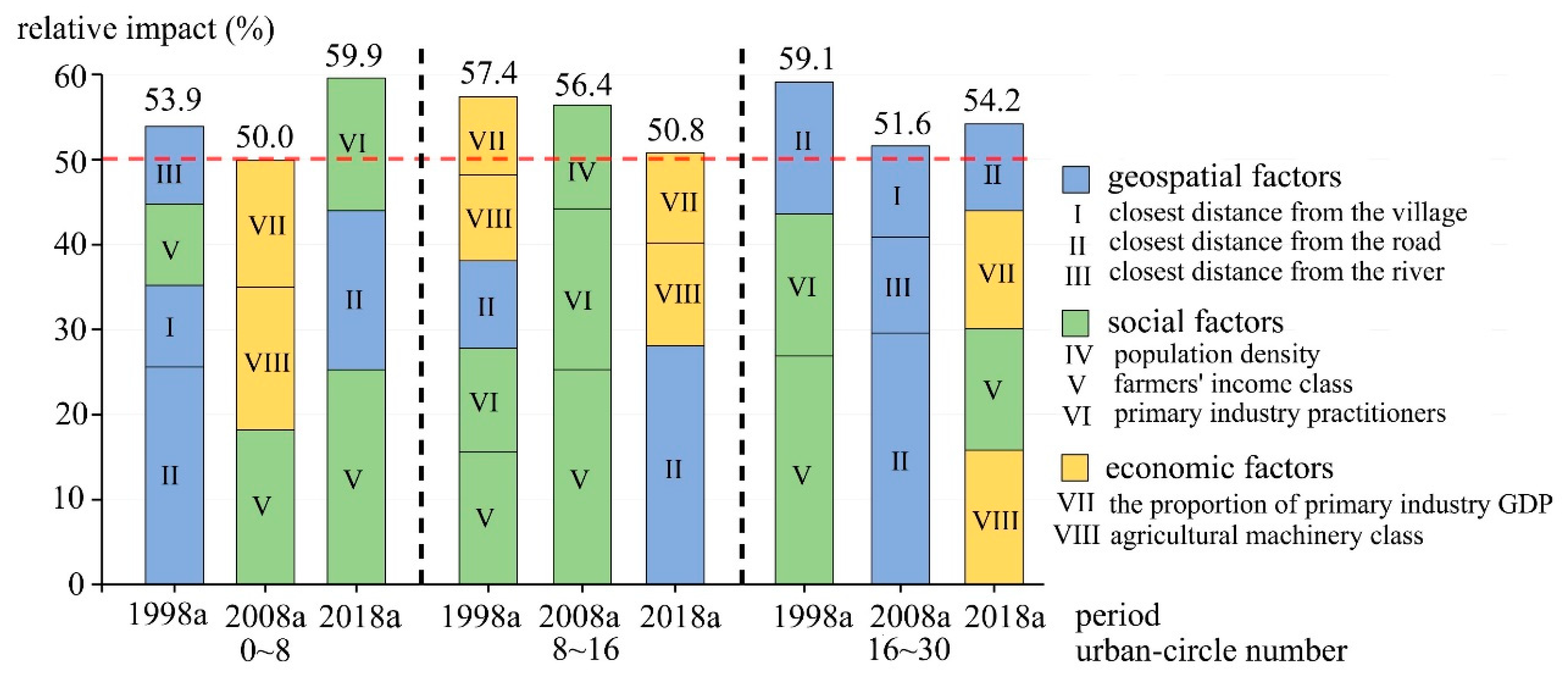Geographical Modeling of Spatial Interaction between Built-Up Land Sprawl and Cultivated Landscape Eco-Security under Urbanization Gradient
Abstract
:1. Introduction
2. Materials and Methods
2.1. Data Source and Processing
2.2. Research Methods
2.2.1. Analysis of Urbanization Gradient and Sprawl Intensity
2.2.2. Analysis of Cultivated Landscape Eco-Security under Urbanization Gradient
2.2.3. Analysis of Driving Factors Based on BRT
3. Results and Discussion
3.1. Spatiotemporal Characteristics of Built-Up Land Sprawl and Cultivated Land Area Change
3.2. Spatiotemporal Characteristics of Cultivated Landscape Eco-Security under Urbanization Gradient
3.3. Driving Factors of Cultivated Landscape Eco-Security Influenced by Built-Up Land Sprawl under Urbanization Gradient
3.4. Discussion
3.4.1. Landscape Pattern and Process of Cultivated Land Based on Urbanization Gradient Analysis
3.4.2. Spatiotemporal Heterogeneity of Cultivated Landscape Ecological Risk under Urbanization Gradient
3.4.3. Interaction among Various Factors Affecting Cultivated Landscape Eco-Security under Urbanization Gradient
4. Conclusions
Author Contributions
Funding
Acknowledgments
Conflicts of Interest
References
- Song, X.Q.; Ou, Y.Z. Route of Multifunctional Cultivated Land Management in China. J. Nat. Resour. 2012, 27, 540–551. [Google Scholar] [CrossRef]
- Meng, Y. Summary of the Seminar on “Standing on the Red Line of 1.8 Billion Mu of Cultivated Land”. J. China Agric. Univ. 2007, 12, 25–26. [Google Scholar]
- Yang, G.; Xie, H.Z. Agricultural land transfer in the process of urbanization. Urban Probl. 2010, 56–62. [Google Scholar] [CrossRef]
- Standardization Administration of China. No. 1 Document of the Central Government in 2019: Strictly Observe the Red Line of 1.8 Billion Mu of Farmland and Ensure the Construction of 800 Million Mu of High-Standard Farmland by 2020; China Standardization: Beijing, China, 2019; p. 24. [Google Scholar]
- Wang, W.L. Comments on the related theories of rural land system reform in China. Southeast Acad. Res. 2012, 19–28. [Google Scholar] [CrossRef]
- Zhao, X.L.; Zhang, Z.X.; Wang, X.; Zuo, L.J.; Liu, B.; Yi, L.; Xu, J.Y.; Wen, Q.K. Analysis of Chinese cultivated land′s spatial temporal changes and causes in recent 30 years. Trans. Chin. Soc. Agric. Eng. 2014, 30, 1–11. [Google Scholar] [CrossRef]
- Dahal, K.R.; Benner, S.; Lindquist, E. Urban hypotheses and spatiotemporal characterization of urban growth in the Treasure Valley of Idaho, USA. Appl. Geogr. 2017, 79, 11–25. [Google Scholar] [CrossRef]
- Yushanjiang, A.; Fei, Z.; Yu, H.; Kung, H.T. Quantifying the spatial correlations between landscape pattern and ecosystem service value: A case study in Ebinur Lake Basin, Xinjiang, China. Ecol. Eng. 2018, 113, 94–104. [Google Scholar] [CrossRef]
- Fjellstad, W.; Dramstad, W. Landscape monitoring as a tool in improving environmental security. In Use of Landscape Sciences for the Assessment of Environmental Security; Springer: Dordrecht, The Netherlands, 2008. [Google Scholar] [CrossRef]
- Li, D.; Liu, Y.Z. Research on the relationship between urbanization development and farmland change in China. Econ. Rev. 2003, 13–15. [Google Scholar] [CrossRef]
- Chen, Z.G.; Wang, Q. A Positive Study on China’s Farmland Conversion and Land Degradation in Transition. China Popul. Resour. Environ. 2005, 47–50. [Google Scholar] [CrossRef]
- Zhou, Y.H.; Cheng, J.M.; Fei, L.C.; Xu, Y.T. Research of cultivated land change in the process of rapid urbanization of Wuhu city. Chin. J. Agric. Resour. Reg. Plan. 2016, 37, 57–62. [Google Scholar] [CrossRef]
- Yang, R.H. Protection of cultivated land in urbanization—A case study of Wuxi city, Jiangsu province. Areal Res. Dev. 1998, 17, 53–57. [Google Scholar]
- Wu, Y.; Zhang, H. Analysis of coordination between farm land protection, food security, and urbanization of Dalian City. Territory Nat. Resour. Study 2017, 24–29. [Google Scholar] [CrossRef]
- Alterman, R. The Challenge of Farmland Preservation: Lessons from a Six-Nation Comparison. J. Am. Plan. Assoc. 1997, 63, 220–243. [Google Scholar] [CrossRef]
- Lichtenberg, E.; Ding, C. Chapter 5: Assessing Farmland Protection Policy in China. Land Use Policy 2008, 25, 59–68. [Google Scholar] [CrossRef]
- Cai, J.M.; Chen, Y.R.; Xiong, C. Urbanization and cultivated land protection. Econ. Perspect. 2015, 44, 78–86. [Google Scholar]
- Estoque, R.C.; Murayama, Y. Landscape pattern and ecosystem service value changes: Implications for environmental sustainability planning for the rapidly urbanizing summer capital of the Philippines. Landsc. Urban Plan. 2013, 116, 60–72. [Google Scholar] [CrossRef]
- Hastie, T.; Friedman, J.; Tibshirani, R. The Elements of Statistical Learning. Technometrics 2010, 45, 267–268. [Google Scholar] [CrossRef]
- Guo, L.; Xue, D.Y.; Yu, S.X.; Cai, L. Assessment and Dynamic Analysis of Landscape Ecological Security of Taishan Mountain. J. Mt. Sci. 2008, 331–338. [Google Scholar] [CrossRef]
- Ou, Q.X.; Li, H.K.; Lei, X.D.; Ying, Y. Difference analysis in estimating biomass conversion and expansion factors of Masson Pine in Fujian Province, China based on national forest inventory data: A comparison of three decision tree models of ensemble learning. Chin. J. Appl. Ecol. 2018, 29, 2007–2016. [Google Scholar] [CrossRef]
- Martin, M.P.; Wattenbach, M.; Smith, P.; Meersmans, J.; Jolivet, C.; Boulonne, L.; Arrouays, D. Spatial distribution of soil organic carbon stocks in France. Biogeosciences 2011, 8, 1053–1065. [Google Scholar] [CrossRef] [Green Version]
- Müller, D.; Leitão, P.J.; Sikor, T. Comparing the determinants of cropland abandonment in Albania and Romania using boosted regression trees. Agric. Syst. 2013, 117, 66–77. [Google Scholar] [CrossRef]
- Li, C.L.; Liu, M.; Hu, Y.M.; Xu, Y.Y.; Sun, F.Y. Driving forces analysis of urban expansion based on boosted regression trees and Logistic regression. Acta Ecol. Sin. 2014, 34, 727–737. [Google Scholar] [CrossRef]
- Jiao, L.L.; Chang, Y.; Shen, D.; Hu, Y.M.; Li, C.L.; Ma, J. Using boosted regression trees to analyze the factors affecting the spatial distribution pattern of wildfire in China. Chin. J. Ecol. 2015, 34, 2288–2296. [Google Scholar] [CrossRef]
- Galpern, P.; Manseau, M.; Fall, A. Patch-based graphs of landscape connectivity: A guide to construction, analysis and application for conservation. Biol. Conserv. 2011, 144, 44–55. [Google Scholar] [CrossRef]
- Chen, Y.; Shao, L.; Zhu, H.C.; Li, W. Rethinking Spatial Model of Small and Medium-sized City Clusters in the Transformative Period:A Study on Weifang Area. Urban Plan. Forum 2017, 86–91. [Google Scholar] [CrossRef]
- Zhong, B.X.; He, T.R.; Zhang, Z.; Wu, Y.Q. Spatial-temporal pattern evolution of cultivated land area and its driving forces of agricultural areas in Huaibei plain. J. South. Agric. 2017, 48, 174–180. [Google Scholar] [CrossRef]
- Li, X.; Ou, M.H.; Ma, X.L. Analysis on Impact of Fragmentation Based on Landscape Index to Cultivated Land Use Efficiency: A Case on Lixiahe District in Yangzhou City. J. Nat. Resour. 2011, 26, 1758–1767. [Google Scholar] [CrossRef]
- Li, X.W.; Fang, J.Y.; Piao, S.L. The comparison of spatial characteristics in urban landuse growth among the central and sub-cities in Shanghai Region. Geogr. Res. 2003, 6, 72–75. [Google Scholar] [CrossRef]
- Yu, X.; Wu, K.N.; Yun, W.J.; Wei, H.B.; Liu, L.; Song, Y.H.; Gao, X. Analysis on temporal and spatial variation of landscape ecological security in modern agricultural area. Trans. Chin. Soc. Agric. Eng. 2016, 32, 253–259. [Google Scholar] [CrossRef]
- Yang, Q.S.; Qiao, J.G.; Ai, B. Landscape ecological security dynamics in a fast growing urban district: The case of Dongguan City. Acta Ecol. Sin. 2013, 33, 1230–1239. [Google Scholar] [CrossRef]
- Li, D.K.; Ding, S.Y.; Liang, G.F.; Zhao, Q.H.; Tang, Q.; Kong, L.B. Landscape heterogeneity of mountainous and hilly area in the western Henan Province based on moving window method. Acta Ecol. Sin. 2014, 34, 3414–3424. [Google Scholar] [CrossRef] [Green Version]
- Zhang, L.L.; Zhao, Y.H.; Yin, S.; Fang, S.; Liu, X.J.; Pu, M.M. Gradient analysis of dry valley of Minjiang River landscape pattern, based on moving window method. Acta Ecol. Sin. 2014, 34, 3276–3284. [Google Scholar] [CrossRef]
- Elith, J.; Leathwick, J.R.; Hastie, T. A working guide to boosted regression trees. J. Anim. Ecol. 2008, 77, 802–813. [Google Scholar] [CrossRef] [PubMed]
- Baggio, J.A.; Salau, K.; Janssen, M.A.; Schoon, M.L.; Bodin, Ö. Landscape connectivity and predator–prey population dynamics. Landsc. Ecol. 2011, 26, 33–45. [Google Scholar] [CrossRef]
- Cushman, S.A.; Raphael, M.G.; Ruggiero, L.F.; Shirk, A.S.; Wasserman, T.N.; O’Doherty, E.C. Limiting factors and landscape connectivity: The American marten in the Rocky Mountains. Landsc. Ecol. 2011, 26, 1137–1149. [Google Scholar] [CrossRef]
- Li, X.Z. The temporal and spatial changes of cultivated land landscape ecological security in Beidaihe new district. Chin. J. Agric. Resour. Reg. Plan. 2017, 38, 59–64. [Google Scholar] [CrossRef]
- Yin, R.; Wei, X.; Li, Z.; Cui, S.; Feng, C.; Xiong, Y.; Xie, P. Potential for forest vegetation carbon storage in Fujian Province, China, determined from forest inventories. Plant Soil 2011, 345, 125–140. [Google Scholar] [CrossRef] [Green Version]
- Yin, R.; Jin, Y.; Wei, X.; Wang, Y.; Yang, Y.; Hua, L.; Xiong, Y.; Xiang, N.; Song, X. Effects of rapid urban sprawl on urban forest carbon stocks: Integrating remotely sensed, GIS and forest inventory data. J. Environ. Manag. 2012, 113, 447–455. [Google Scholar] [CrossRef]
- Li, X. Urban-rural Integration and Rethinking of Small Towns Theory. J. South China Agric. Univ. (Soc. Sci. Ed.) 2019, 18, 131–140. [Google Scholar] [CrossRef]
- Gartaula, H.; Patel, K.; Johnson, D.; Devkota, R.; Khadka, K.; Chaudhary, P. From food security to food wellbeing: Examining food security through the lens of food wellbeing in Nepal’s rapidly changing agrarian landscape. Agric. Hum. Values 2016, 34, 1–17. [Google Scholar] [CrossRef]
- Gao, J.L.; Chen, J.L.; Su, X. Urban expansion and its driving mechanism in China: From three main schools’ perspectives. Prog. Geogr. 2013, 32, 743–754. [Google Scholar] [CrossRef]
- Jiang, H.C. Urbanization and Poverty Reduction of Rural to Urban Residents. J. South China Agric. Univ. (Soc. Sci. Ed.) 2017, 16, 75–95. [Google Scholar] [CrossRef]
- Fu, Y. Implication of Land Transfer Policy in Shenzhen Urbanization for Land System Reform in New-type Urbanization. J. Shenzhen Univ. (Hum. Soc. Sci.) 2018, 35, 28–36. [Google Scholar] [CrossRef]









| Factors | Urban-Circle 0–8 | Urban-Circle 8–16 | Urban-Circle 16–30 | ||||||
|---|---|---|---|---|---|---|---|---|---|
| 1998 | 2008 | 2018 | 1998 | 2008 | 2018 | 1998 | 2008 | 2018 | |
| Population density | 3.8 | 3.9 | 11.4 | 6.9 | 12.2 | 3.1 | 7.5 | 2.9 | 5.4 |
| Primary industry practitioners | 7.5 | 5.6 | 15.6 | 12.2 | 18.9 | 3.6 | 16.7 | 4.2 | 8.1 |
| Farmers’ income class | 9.6 | 18.3 | 25.3 | 15.6 | 25.3 | 6.2 | 26.9 | 9.2 | 14.3 |
| Number of industrial enterprises | 5.7 | 11.2 | 2.2 | 7.6 | 4.1 | 6.1 | 4.4 | 6.7 | 8.6 |
| Agricultural machinery class | 8.4 | 16.8 | 4.1 | 10.1 | 5.7 | 12.1 | 5.9 | 8.3 | 15.8 |
| Proportion of primary industry GDP | 7.4 | 14.9 | 4.6 | 9.2 | 3.5 | 10.6 | 4.8 | 6.1 | 13.9 |
| Per-hectare grain output | 6.5 | 5.9 | 2.3 | 7.6 | 2.4 | 4.8 | 3.3 | 3.1 | 5.8 |
| Cultivated land potential production | 4.9 | 6.7 | 1.8 | 7.5 | 2.1 | 6.4 | 2.6 | 3.4 | 7.8 |
| Closest distance from the road | 25.6 | 5.5 | 18.7 | 10.3 | 11.4 | 28.1 | 15.5 | 29.6 | 10.2 |
| Closest distance from the village | 9.6 | 5.4 | 5.3 | 6.5 | 7.1 | 7.7 | 5.6 | 10.7 | 3.9 |
| Closest distance from the river | 9.1 | 4.8 | 7.5 | 5.1 | 5.6 | 9.5 | 6.4 | 11.3 | 5.7 |
| Elevation | 1.9 | 1.1 | 1.2 | 1.4 | 1.7 | 1.8 | 0.4 | 4.5 | 0.5 |
© 2019 by the authors. Licensee MDPI, Basel, Switzerland. This article is an open access article distributed under the terms and conditions of the Creative Commons Attribution (CC BY) license (http://creativecommons.org/licenses/by/4.0/).
Share and Cite
Cai, H.; Ma, K.; Luo, Y. Geographical Modeling of Spatial Interaction between Built-Up Land Sprawl and Cultivated Landscape Eco-Security under Urbanization Gradient. Sustainability 2019, 11, 5513. https://doi.org/10.3390/su11195513
Cai H, Ma K, Luo Y. Geographical Modeling of Spatial Interaction between Built-Up Land Sprawl and Cultivated Landscape Eco-Security under Urbanization Gradient. Sustainability. 2019; 11(19):5513. https://doi.org/10.3390/su11195513
Chicago/Turabian StyleCai, Han, Kun Ma, and Yunjian Luo. 2019. "Geographical Modeling of Spatial Interaction between Built-Up Land Sprawl and Cultivated Landscape Eco-Security under Urbanization Gradient" Sustainability 11, no. 19: 5513. https://doi.org/10.3390/su11195513





